Going to see Blade Runner again on Saturday night was like sleeping with an old friend that you had not seen for years. It was exciting, but not entirely unexpected; it was what you remembered, but with other parts you had forgotten how they went together; it was like being home at last, but it was also just as good as the first time. There is nothing quite like a big screen to bring it home to you – Blade Runner is nothing if not the perfect film to see on a big screen in a large movie house – and the Embassy is my cinema of choice. (Confession time: I never much liked the Paramount as a movie cinema, but I like the outside of the building very very much. It would be dumb to make it into a Hotel or Apartments, as it is just so damn noisy there at night, but the interior always felt too botched around and the screen was too small and let’s face it, the chairs were weird. But I’ll still miss it). So: back to the Embassy I go – I have a feeling I may have seen the original Blade Runner at the Civic in Auckland in 1982, so from one magical atmospheric theatre to another, perhaps you, like me, might like watching one fantasy from within inside another fantasy.
How do I love Blade Runner? Let me count the ways.
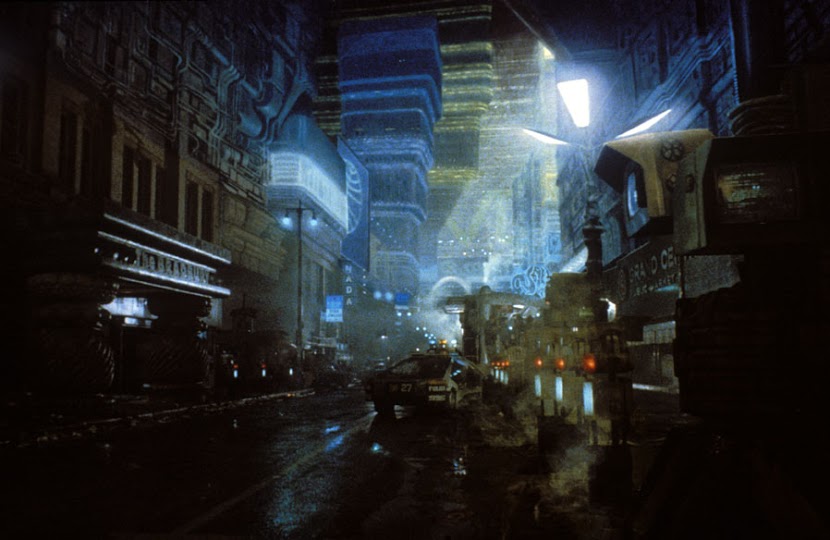
The movie is, of course, a psycho-analyst’s wet dream, with Oedipal machinations of killing your father, although I must confess that it was only this time that I heard Rutger Hauer say his line clearly as “I want more life, Father!â€. Honestly, up until last night I had always thought Roy had said “I want more life, Fucker!†which to me is more truthful and more likely, even if less fully compliant with Psych 101. The replicants are, naturally, superbly crafted, not so much in the likeness of their maker, but in the likeness of a perfect being. And they’re sexy as hell, whether in their hell on earth in Los Angeles 2019 (only two years away!) or watching attack ships on fire on the shoulder of Orion. Can robots be sexy? Can they ever! But some are unsure. Louis Armand puts it like this in his LOLA Journal, “In Blade Runner, the issue of sexuality is never clear-cut. Next to the question of whether or not a machine can be intelligent seems to be posed the question: What does it mean for a machine to experience desire?â€
It is more likely to be the other way round – mankind always experiences desire, whether logically (for another human) or illogically (name your favourite fetish), and so why wouldn’t humans fall in love (or lust) with a robot that looks like the most gorgeous person they’ve ever seen?
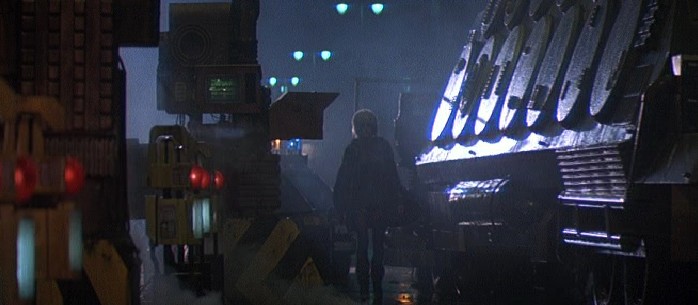
But, Rutger Hauer and Darryl Hannah aside, Blade Runner is about so much more than sexy actors playing Nexus 6. It is, of course, above all, a commentary on humankind’s impending apocalypse of doom, both with over-population, and with climate change. I had forgotten how much it rained in the film – basically, every single scene set outside it is pouring down, and no one bats an eye. It is the new normal – the altered state of the sky – giant flames flare out from oil refineries while Chinese street kids ride past on bicycles. Ridley Scott got most of it right when he set the film in Los Angeles, except for the ethnicity: the lingua franca of the street people in LA is now Hispanic, rather than Chinese. But it is close to the mark in other cities, such as Vancouver, Sydney, parts of Auckland. That’s a similar ethnic mix to Fifth Element (which I also saw here at the Embassy just a few weeks ago), with a polyglot Chinoiserie on display amongst the many varied people of the galaxy.
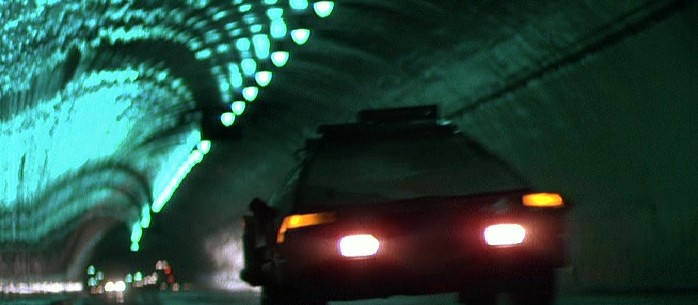
What Blade Runner got right for me was the vision of the future as already lived in: a grimy, stained, rubbish-strewn vision of domestic urban reality, rather than the stark white cleanness of Stanley Kubrik’s 2001, where everything remained spotless until death. I went to see 2001 many many moons ago, on what could have been another planet for the cold and frosty reception I got from the film. Actually, I got that cold and frosty part more from my prospective girlfriend at the time, Rachel, who clearly did not enjoy the machinations of HAL 9000 and both of us got thoroughly weirded out by the hallucinogenic part at the end, but just a word of warning that I wish I had had at the time: worst movie for a first date, ever.

Ridley Scott, by contrast, has the details down pat. I reviewed Kubrick’s 2001 here and that just reinforced to me the stark white crispness of my early memories, but I don’t think I’ve ever written about Blade Runner before, which is odd, as it must be one of the more written-about films of all time. There are parallels with other films that haven’t lasted as well – Lars van Trier’s early film Europa for instance, and depictions of Los Angeles that are only just a fraction weirder than the existing truth. Apart from the climate change, of course: seriously, as they said in the song, it never rains in Southern California, but it pours, man it pours. The segue from Blade Runner to Star Wars to Indiana Jones hadn’t hit me before, but of course the common thread is our man Ford. He is young in Blade Runner – so young, but still starting a lifetime of getting beaten up by baddies, or replicants, or Jabba with a sand hog, or Lord Vader with a tray, in the canteen. Honestly, it all came together for me.
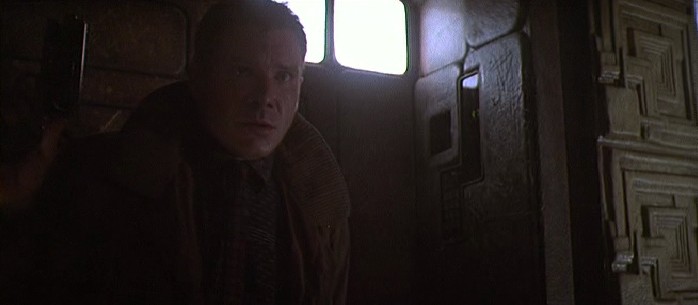
There are other parts that have not made it so far into the future. Giant logos on buildings proclaim Coca Cola – so far, so good – but also buildings are crested with logos of PanAm – Ha! – and TDK – i mean, honestly, who even remembers when they disappeared? Just as 2001 featured a PicturePhone courtesy of AT&T, so too did Blade Runner feature a video call from a downtown grimy videophone, cost of call $1.25 coming up on a graffiti-ridden video screen. Neither film predicted the end of the telephone booth all together, or the advent of the iPhone, although Kubrick’s clean white interiors obviously echo Job’s design ethos. Neither did Ridley seem to have predicted the passion that Americans have for guns – isn’t it extraordinary that only Deckard has a gun, when so many other people nearby appear to be unarmed? Nowadays in L.A. if an undercover cop pulled a gun on a crowded street and mowed down an erotic snake charmer in a bikini and a plastic see through raincoat, there’d be hell to pay. Back then in the 80s, their vision of the future was that no one would blink an eye. Nothing to see here, move along folks. But here, now, in 2017, if not 2019 as well, we have a people gradually learning how to stick up for each other. Black Lives Matter. Indeed. But apparently, ones in Puerto Rico don’t matter so much.

Locations in the original are vibrant and exciting. The Bradbury Building is a personal favourite, dating back to 1893, the film uses the actual building for the interior of CF Sebastian’s apartment building, but a film set for a very different exterior. The tall internal atrium and it’s ornate cast iron metalwork seem somehow appropriate, especially with water dripping through the skylight, reflecting floating airships exhorting you to move ‘Off-World’, wherever that is. Somewhere near the Tannhauser Gate, perchance? Also featured lovingly, to all the architectural voyeurs out there, is the Ennis House, seemingly from both the inside and the outside, although Wiki tells me that only the external shots are true. We’re all glued to the screen, watching the aged sandstone of a genuine original FLW block surround Deckard’s kitchen, except that it is not: its a studio, naturally. Interesting to note that in a film set about the future, the most futuristic parts are those that were designed by FLW, the architect who refused to be bound by convention.
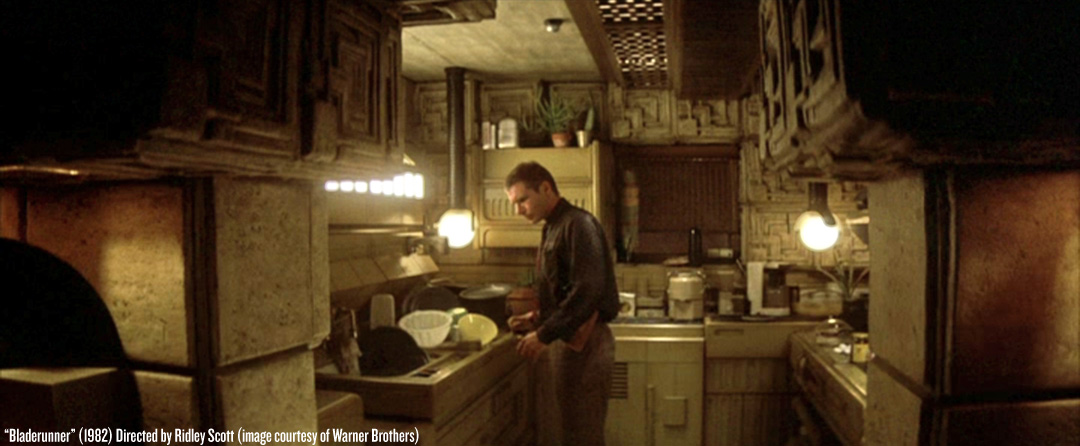
The story of Blade Runner seemed impossible to fathom at the time, but easier to follow the clues this time around. In three or four days time, we have the opportunity to revel in the mystery once more of Blade Runner 2049, the sequel set 30 years after the original, which is round about the time we’ve had to watch the original around a million times. In another 30 years, will they do another sequel? And will we still be waiting for our flying cars?




You weren’t mistaken about the fucker:
“I want more life, father.” – Workprint, Final Cut
“I want more life, fucker.” – Theatrical, International, Director’s Cuts.
“I want more life.” – Alt. broadcast version (shown in Dangerous Days.)
IAccording to the Bladenerds at http://www.bladezone.com/bz_forum/viewtopic.php?f=1&t=2320)
Thanks James – I feel vindicated. Rutger never lies….
Commentary from someone else, possibly Puffin Nubbins:
There’s a brief but excellent analysis on the Architecture of Film blog that is worth checking out. Its writer, architect Benjamin Marcus, definitely gave me an Aha! moment when he wrote “Between the imaginings of visual futurist Syd Mead, the selectively edited interiors of FLWright’s Ennis House, and the direction of Ridley Scott, the residential interiors of hard-boiled cop Deckard reveal the lived-in layers of time, at once suggesting the gritty detritus of a post-apocalyptic future, (to repell us), the shadows of 1940s film-noir (to put us on edge), and the romantic remains of mid-20th century home life (to draw us in).”
Been off-world yourself Levi?
Watch for Pan Am advertising in the sequel. Another nod, perhaps, to Kubrick and his moonliner?
Starkive – working in the colonies on the Flosten Paradise actually, had to quell a rebellion from the minions at the Ministry of Mumblespeak. C-Beams glittering in the dark, attack ships on fire off the shoulder of Orion, you know the drill.
Shall we say….
The light that burns twice as bright burns half as long – and this blog has burned so very, very brightly.
I’ve done… questionable things.
Also extraordinary things; revel in your time.
While you can argue that Scott and Kubrick show different futures,
You can also argue that they simple show different aspects of a single future,
JF Sebastian is trapped on eath because he couldn’t pass the Medical,
“A new life awaits you in the off-world colonies!”
Deckard’s world is one of what is left when society beoomes more and more devided, those that can have left for the stars, but those that cannot go are left behind….
While Kuricks’s world can been seen as the flip side, we see a technical class out amongst the stars…., but we never see those who remain on earth,,,
Its all very Eloi and Morlocks to me
I guess you’re right – they certainly both show a move towards living Off World, although my point was more about what that world might be like. Clean, white, positive, and everything working – or just more grime and dirt, the same as we already have here on earth. Maybe I’m thinking too simply – maybe, in fact, those who escape have a brilliant white catered future, while those who stay have to deal with the detritus of all those who have left. In which case it is more Up vs Wall-E….
OK – a question for Starkive perhaps, who seems to know more about films than almost anyone (i wonder why…): i saw a film when i was younger, which I have always thought was called Europa Europa, and I remember it being Black and White and yet lit occasionally with a yellowish light – and i think it had Brian Dennehy in it as a cop, it was always raining, and there were strange young men who committed suicide by jumping off tall towers with ropes tied to their legs so they were stopped just before they would hit the ground. I watched it one day in Auckland at Charlie Grays Picture Theatre, and have never seen or heard of it again.
But what was it really? I look on IMDB and it doesn’t seem to match my memory. There’s also Europa, by Lars van Trier, but that’s different too. And Brian Dennehy isn’t in either of them. Clearly my mind is going wacko, combining several different clues, except that in my memory they are quite definitely from the same film. Anyone want to tell me?
Hmmm.
I would need a Voight-Kampf Empathy Test to be sure, but I suspect you are experiencing an implanted memory. I can’t find any trace of Brian and the non-elastic bungy jumpers either. However, I can commend a lost NZ dystopian flick:
https://www.youtube.com/watch?v=C0mKCAWoMZ4
A different genre mash, steam punk-vampire rather than sci-fi noir, but it does for Dunedin what Scott does for LA (and on a fraction of the money naturally). Cruelly sunk by Hollywood politics.
Thanks Starkive, for trying. I suspect my Brian Dennehy memory is the wrong bit – presumably some other actor – but the raining and the jumping is genuine memory. I can even quote lines of dialogue from it. Very weird. Never mind, i’ll figure it out one day.
Thanks for that clip – it did actually look completely Hollywood worthy – didi they make the whole movie, or just a trailer? Recognised a few voices and faces in there!
OK – as a treat, and just in case I lose it, I’m posting up here a magical repository of behind-the-scenes pics of the props department on Blade Runner. I found it to be a treasure trove. Enjoy. https://imgur.com/a/mv8qf
PC did indeed get made… but was never properly released because of change of management at the US studio which backed it. You can read about it here (ahem):
https://www.tepapa.govt.nz/about/te-papa-press/history-titles/new-zealand-film-illustrated-history-0
And if you want a classic combination of dystopia and pristine shiny whiteness, try this:
https://www.youtube.com/watch?v=rO99j_Ty4Hc
Long before the Skywalker money, George Lucas had to find a set of real places to get the dire grimness he wanted. Not sure which architects would put this on their CVs.
They made it – I saw it at a film festival I think. Tolerable for its genre…
Oh, and on topic, my view of Bladreunner (which I’ve seen multiple times – and own the DVD of) cannot helped but be coloured by the subsequent decades of architecture student projects that seem to think that dystopia SHOULD be a designed future. Granted – architects demonstrated in the mid-twentieth century that they sucked at designing utopias, but surely the pendulum swings too far when dystopian futures are imagined as architectural solutions?
I’ve always preferred the less earnest and more Kafkaesque “Brazil” anyway…
m-d. – I sent my students to see Brazil when it came to the Embassy about 4 years ago – I was raving about it – total blank incomprehensible looks from most of them !
Monty Python humour just doesn’t cut it these days!
Also, those ’80s graphic effects though!
It suddenly occurred to me that both Monty Python and Kafka were interested in exploring absurdity, just from radically different positions. Perhaps that IS the brilliance of “Brazil”?
So what happened to Rachel?
Why, hello 60 ! Fancy finding you here! I thought you had abandoned me, much as i had abandoned myself for a while.
Rachael: May I ask you a personal question?
Leviathan: Sure.
Rachael: Have you ever retired a human by mistake?
Leviathan: No.
Rachael: But in your position, that is a risk.
Rachael: It seems you feel our work is not a benefit to the public.
Leviathan: Replicants are like any other machine – they’re either a benefit or a hazard. If they’re a benefit, it’s not my problem.
Rachael: Is this testing whether I’m a replicant or a lesbian, Mr. Levi?
Tried posting this from an off-world location earlier this week – doesn’t seem to have got through moderation. I’ll try again.
PC did indeed get made… but was never properly released because of change of management at the US studio which backed it. You can read about it in this book (ahem):
https://www.tepapa.govt.nz/about/te-papa-press/history-titles/new-zealand-film-illustrated-history-0
And if you want a classic combination of dystopia and pristine shiny whiteness, try this:
https://www.youtube.com/watch?v=rO99j_Ty4Hc
Long before the Skywalker money, George Lucas had to find a set of real places to get the dire grimness he wanted. Not sure which architects would put this on their CVs.
Tried posting this from an off-world location earlier this week – doesn’t seem to have got through moderation. I’ll try again with modifications.
PC did indeed get made… but was never properly released because of change of management at the US studio which backed it.
And if you want a classic combination of dystopia and pristine shiny whiteness, try this:
https://www.youtube.com/watch?v=rO99j_Ty4Hc
Long before the Skywalker money, George Lucas had to find a set of real places to get the dire grimness he wanted. Not sure which architects would put this on their CVs.
Hooray – I’ve figured out the film I was trying to remember. It was Lars van Trier’s first film, The Element of Crime, which features Michael Elphick (not Brian Dennehy), a similarly bulky, doughty bloke, as Fisher, who is investigating a murder.
Wikipedia says: “The world depicted in the film is semi-derelict. Disordered collections of similar or identical objects are found in many of the scenes, reinforcing the sense of a crumbling society. Examples include white paper, light bulbs, heaps of keys, surgical scissors, glass bottles, rubber stamps and Coca-Cola cans. The film’s slow pace, dark visuals and occasional surreal imagery give it a dreamlike quality. In addition, much of the dialogue is contradictory.”
People jumping off tower cranes.
Sounds like good viewing for the next family pizza/movie night!